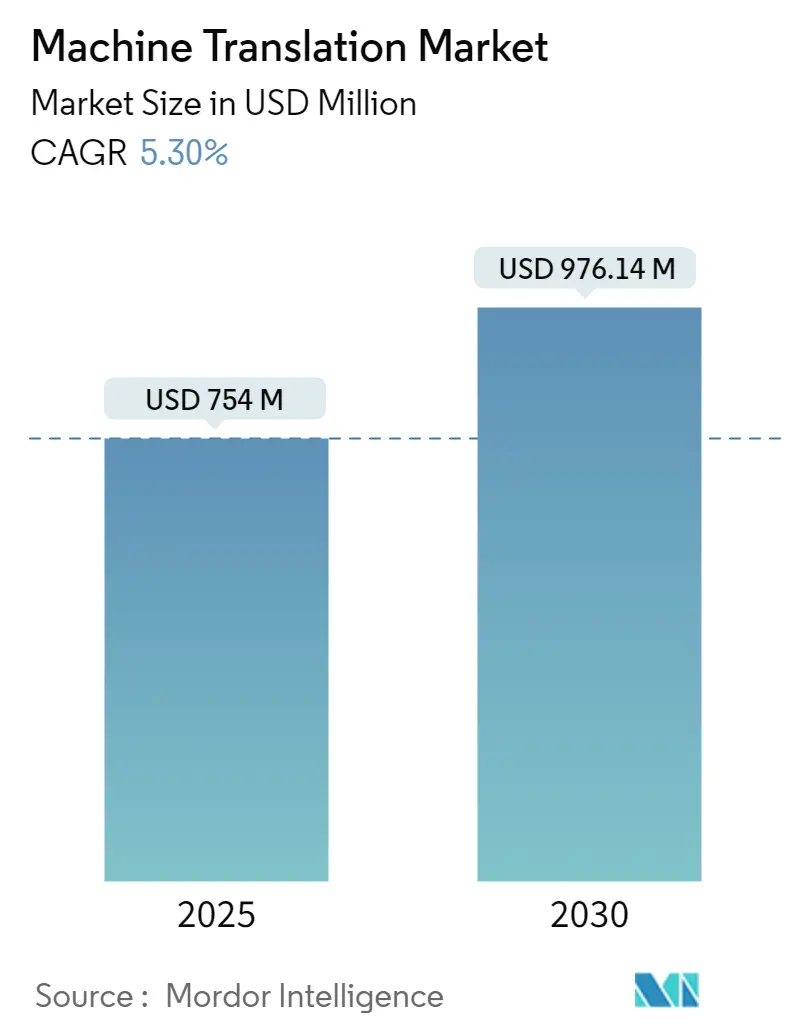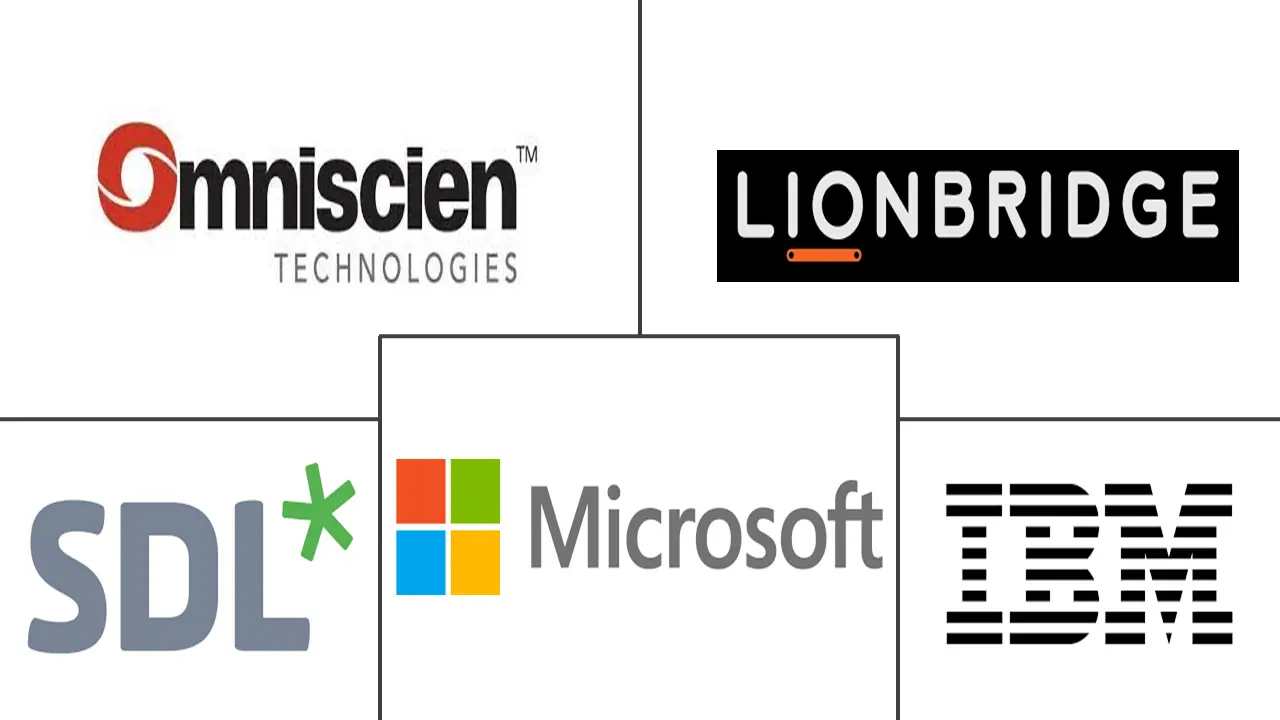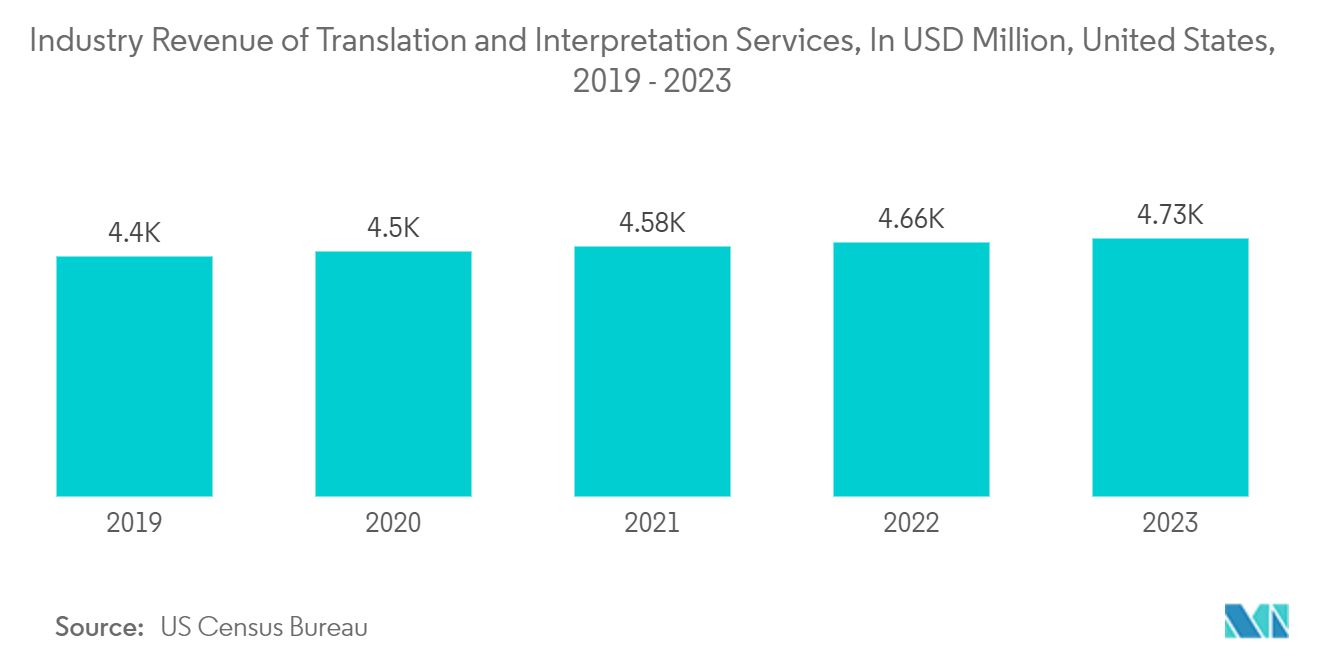
| Study Period | 2019 - 2030 |
| Market Size (2025) | USD 754.00 Million |
| Market Size (2030) | USD 976.14 Million |
| CAGR (2025 - 2030) | 5.30 % |
| Fastest Growing Market | Asia Pacific |
| Largest Market | North America |
| Market Concentration | Low |
Major Players
*Disclaimer: Major Players sorted in no particular order |
Machine Translation Market Analysis
The Machine Translation Market size is estimated at USD 754.00 million in 2025, and is expected to reach USD 976.14 million by 2030, at a CAGR of 5.3% during the forecast period (2025-2030).
Due to the growing usage of computer-assisted tools, the machine translation business is experiencing excess demand. Therefore, the need to use technology to improve translation efficiency is constantly growing.
- The increased demand for content localization among businesses will boost the growth of the machine translation sector. The conventional approach of utilizing human translators to correctly localize content for a specific place or population takes time and money. This has led businesses to spend money on machine translation software, which enables them to translate content for a particular audience quickly. As more companies make their goods and services available in other markets, there will be an increase in the need for translation and localization services in the coming years.
- This continual rise may be explained by the development of emerging economies and the globalization of several businesses that aim to offer their information, goods, and services in as many languages as possible. This limitation may push translation companies to rely more heavily on machine translation software.
- Additionally, the text is translated faster thanks to machine translation technologies. A few translation agencies use it to provide multilingual material. This technology increases translators' productivity regarding terminology, localization, and translation work. One of the most widely used machine translation technologies is Google Translate, which covers about 130 languages and is closely related to the search engine and Android OS.
- The market for machine translation is experiencing excessive demand due to the growing use of computer-assisted tools. Because of this, technology is increasingly needed to enable a more efficient translation process.
- Machine translation (MT) separates the structure of a source language into elements that can be translated into a word of the same structure in the target language. The most significant defect of machine translation is its low quality and often inaccurate translations. Machine translators need help understanding context or the creative use of language, such as slogans and metaphors, resulting in a word-for-word translation that makes little sense when translated into different languages.
- Nearly all translation-related areas were impacted by COVID-19, including demand, income, and employment practices. Despite the difficulties that translators encounter, the interpreting industry was impacted the worst, with a 24% decline in revenue compared to an 8% decline for translators.
Machine Translation Market Trends
Neural Machine Translation is Expected to Drive the Market Growth
- The emergence of neural machine translation (NMT) during the past several years has been among the most fascinating advancements in automated translation. The method predicts the likelihood of a set of words using massive amounts of data given into an artificial neural network, often modeling the complete sentence in a single integrated model. In other words, the model learns by doing in artificial translation intelligence.
- NMT is also constantly being enhanced and refined, and it's expected to improve over the coming several years. They are anticipated to be integrated with analytics and other industry-wide software solutions, allowing for natural language inquiries and machine responses, increasing the efficiency with which these solutions are used. Organizations may choose these solutions due to the significant cost savings associated with their adoption.
- To fulfill rising customer demands, businesses are putting more and more effort into creating cutting-edge machine translation systems. For instance, Amazon announced the release of Sockeye 3, the most recent version of its Sockeye toolkit, in July 2022. Sockeye 3 enables the rapid and practical training of neural machine translation (NMT) models. Compared to other PyTorch implementations, Sockeye 3 runs up to 292 percent faster on CPUs and 126 percent faster on GPUs.
- The Neural machine translation can translate thousands of user-generated comments much more quickly and accurately while producing findings that can be used. As a result, the businesses will be able to engage with clients globally more meaningfully, which is essential for a successful global marketing strategy.
North America to Hold Maximum Market Share
- Due to growing demand in the US IT sector, which accounts for most regional demand, One of the most prominent marketplaces for is in North America machine translation. To meet the needs of international consumers, some of the most well-known IT companies in the area were among the first to implement this technology.
- Various service providers and a supportive government characterised the region's expansion. For instance, the SMT services offered by Google Inc. and Microsoft Corporation and their free internet search engines have become more prevalent in the United States. Additionally, the machine translation market in North America is projected to grow due to the technological behemoths' increased investments in and advancements in machine learning and artificial intelligence.
- North America is home to the majority of the industry's major players, which is one of the important factors contributing to the high market share of the area. A few significant companies in North America have banded together to take advantage of the most recent technical advancements that can be implemented into their business models. Inventus has fully integrated automatic machine translation into its products for eDiscovery services. With the help of Inventus, Iconic Translation Machines Ltd., a well-known translation software provider, can now offer its most recent Neural Machine Translation solution on-premise or in the cloud.
- A few businesses in the area are focusing on technological development. For instance, Facebook invests much money in machine translation (MT). Facebook is currently working on two other projects that will share information with the greater open-source community and enable developers to improve the technology, in addition to increasing quality estimation and several other initiatives.

Machine Translation Industry Overview
The machine translation market is competitive and consists of several major players. Current market leaders in terms of market share include companies like IBM Corporation, Microsoft Corporation, Lionbridge Technologies Inc., etc. The majority of well-known companies are, however, increasing their market position by gaining new contracts in order to tap into new markets as a result of the increased innovation in machine translation.
In January 2023, Siemens expanded its digitalization portfolio for the Indian machine tool industry to enhance value proposition and profitability for customers, where it expanded its portfolio of the machine tool industry, which will enable manufacturers and users of machine tools to design, realize, and optimize machines and components faster, react flexibly to market demands, and enhance productivity across various user industries.
In August 2022, RWS announced the partnership with Language Weaver, where Reynen Court offers a platform that combines a content-rich app store and a powerful control panel that simplifies the process for law firms and legal departments to source, evaluate, deploy, monitor and manage legal technology applications. The platform offers Language Weaver, RWS's state-of-the-art machine translation technology, to legal firms looking to improve multilingual communications and eDiscovery. Reynen Court clients benefit from access to 3,000 language combinations within Language Weaver's secure environment.
Machine Translation Market Leaders
-
IBM Corporation
-
Microsoft Corporation
-
SDL PLC
-
Lionbridge Technologies Inc.
-
Omniscien Technologies Inc.
- *Disclaimer: Major Players sorted in no particular order
.webp)
Machine Translation Market News
- Feb 2023: RWS announced the launch of its TrainAI brand, offering clients complete, end-to-end data collection, data annotation, and data validation services for all types of AI data - in any language, at any scale, where TrainAI provides machine translation and AI training data services to improve the quality of machine learning models and AI applications for the world's largest organizations.
- Sept 2022: Tarjama, an Arabic machine translation (AMT) website called Tarjama Translate, was launched by a language services provider in the MENA region, with a focus on businesses that need quick access to translation in order to reach Arabic-speaking clients.
Machine Translation Industry Segmentation
Machine translation (MT) refers to fully automated software that can translate source content into target languages. Humans may use MT to help them render text and speech into another language; The MT software may operate without human intervention. MT tools are often used to translate vast amounts of information, involving millions of words that could not be translated the traditional way. The quality of MT output can vary considerably, and MT systems require training in the desired domain and language pair to increase quality.
The Machine Translation Market is segmented by Technology (Statistical Machine Translation, Rule-based Machine Translation, and Neural Machine Translation), Deployment (On-premise and Cloud), End-user Vertical (Automotive, Military and Defense, Healthcare, IT, and E-commerce), and Geography (North America, Europe, Asia-Pacific, and the Rest of the World). The market sizes and forecasts are provided in terms of value (USD) for all the above segments.
| By Technology (Qualitative Trend Analysis) | Statistical Machine Translation | ||
| Rule-based Machine Translation | |||
| Neural Machine Translation | |||
| Other Technologies | |||
| By Deployment | On-Premise | ||
| Cloud | |||
| By End-user Vertical | Automotive | ||
| Military and Defense | |||
| Healthcare | |||
| IT | |||
| E-Commerce | |||
| Other End Users | |||
| By Geography | North America | United States | |
| Canada | |||
| Europe | Germany | ||
| France | |||
| United Kingdom | |||
| Rest of Europe | |||
| Asia Pacific | India | ||
| China | |||
| Japan | |||
| Rest of Asia Pacific | |||
| Rest of the World | |||
Machine Translation Market Research FAQs
How big is the Machine Translation Market?
The Machine Translation Market size is expected to reach USD 754.00 million in 2025 and grow at a CAGR of 5.30% to reach USD 976.14 million by 2030.
What is the current Machine Translation Market size?
In 2025, the Machine Translation Market size is expected to reach USD 754.00 million.
Who are the key players in Machine Translation Market?
IBM Corporation, Microsoft Corporation, SDL PLC, Lionbridge Technologies Inc. and Omniscien Technologies Inc. are the major companies operating in the Machine Translation Market.
Which is the fastest growing region in Machine Translation Market?
Asia Pacific is estimated to grow at the highest CAGR over the forecast period (2025-2030).
Which region has the biggest share in Machine Translation Market?
In 2025, the North America accounts for the largest market share in Machine Translation Market.
What years does this Machine Translation Market cover, and what was the market size in 2024?
In 2024, the Machine Translation Market size was estimated at USD 714.04 million. The report covers the Machine Translation Market historical market size for years: 2019, 2020, 2021, 2022, 2023 and 2024. The report also forecasts the Machine Translation Market size for years: 2025, 2026, 2027, 2028, 2029 and 2030.
Our Best Selling Reports
Machine Translation Industry Report
The Global Machine Translation Market is on the rise, fueled by the growing need for multilingual communication and the widespread adoption of machine translation engines across diverse sectors. Innovations in Artificial Intelligence (AI) and Natural language processing (NLP) have significantly enhanced the accuracy and efficiency of these engines, making them indispensable in e-commerce, healthcare, legal services, and education. The shift towards neural machine translation (NMT) promises even greater precision, further integrating machine translation engines into global communication strategies. Additionally, the surge in cloud-based services offers scalable, cost-effective options for businesses of all sizes. As the technology evolves, it's set to diminish language barriers, enabling smoother cross-cultural interactions. Market statistics, including share, size, and revenue growth, are detailed in Mordor Intelligence™ Industry Reports, which provide a comprehensive market forecast and historical overview. For a deeper insight, a free report PDF download is available, showcasing the potential and advancements in the machine translation sector.





